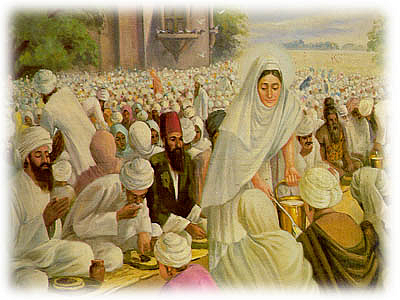Indian society in the past was often unfair to women. They were denied education, excluded from decision-making, and treated as inferior to men. Many cruel practices, such as female infanticide, child marriage, and sati (where a widow was forced to burn herself on her husband’s funeral pyre), existed. It was in this atmosphere of inequality that Guru Nanak Dev Ji, the founder of Sikhism, was born on April 15, 1469, at Rai Bhoi Ki Talwandi (now in Pakistan). As we prepare to celebrate his birth with Guru Nanak Jayanti on Wednesday, November 5, 2025, it is essential to revisit his profound message on the status of women, a message that remains as relevant today as it was centuries ago.
Guru Nanak Dev Ji’s Message of Equality
Guru Nanak Dev Ji strongly opposed the idea that women were inferior. He reminded people that all human beings, whether male or female, are equal before God. His words are clear:
“In a woman, man is conceived, From a woman he is born, With a woman he is betrothed and married, With a woman he contracts friendship. Why denounce her, the one from whom even kings are born? From a woman a woman is born, None may exist without a woman.”
Through these verses, Guru Nanak explained that life itself is possible only because of women. He rejected the idea that women should be treated as less important or be excluded from religion, education, or society.
Women in Religious and Social Life
Before Guru Nanak, women were kept away from participating in religious practices. But Guru Nanak allowed women to pray, sing hymns, and join religious gatherings alongside men. He also made sure that women were included in the community kitchen, or langar, where everyone, regardless of gender, caste, or wealth, could cook, serve, and eat together. This practice broke many social barriers and set an example of true equality.
His teachings inspired his successors as well. Mata Khivi, wife of Guru Angad Dev Ji, managed the langar for nearly 30 years and became known for her service. Later, Guru Gobind Singh Ji, the tenth Guru, also ensured that women were included in the Khalsa initiation ceremony and had the same spiritual responsibilities as men.
Raising Women’s Status in Society
Guru Nanak condemned practices like female infanticide and sati. He taught that these customs were against humanity and against God’s will. He gave women dignity and a voice at a time when they were silenced. By allowing them equal participation in religious and social life, he revolutionized the way society saw women.
Sikhism thus became a religion that recognized women as equal members of the community. Women were encouraged to learn, work, and participate in political, social, and cultural life. Guru Nanak’s teachings planted the seed of women’s empowerment centuries before modern movements for equality began.
Important Sikh Women in History
Guru Nanak’s own sister, Bebe Nanaki, is remembered as his first follower. She recognized his spiritual greatness early in his life and supported him. Her role shows how important women have been in Sikh history.
Other Sikh Gurus also encouraged the active role of women. Guru Angad promoted the education of all Sikhs, including women. Guru Gobind Singh warned Sikhs never to disrespect women, even during wartime. These lessons built a strong foundation for women’s place in Sikhism.
Sikh Women in the Modern World
Today, Sikh women continue to play important roles. They can lead prayers in gurdwaras, serve as granthis (readers of the Guru Granth Sahib), and participate fully in religious ceremonies. More women are also choosing to wear the turban, a symbol of equality, to express their identity with pride.
In many parts of the world, Sikh women have become teachers, leaders, social workers, and professionals. This reflects Guru Nanak’s vision of equality, where women are not limited by gender roles but are respected as equal contributors to society.
Witnessing Equality in Action This Guru Nanak Jayanti
The principles Guru Nanak established are not just historical texts; they are a living reality in every Gurdwara. During Guru Nanak Jayanti, you can witness this equality firsthand:
In the Langar (Community Kitchen): You will see men and women from all backgrounds cooking, cleaning, and serving food together, with no task assigned by gender.
In the Darbar Sahib (Main Hall): Women actively participate in and lead the singing of Shabad Kirtan (devotional hymns) and can serve as Granthis (readers of the Guru Granth Sahib).
In the Sangat (Congregation): Women and men sit together as equals to listen to the teachings and participate in prayers.
The Turban: Increasingly, Sikh women are choosing to wear the turban, a powerful symbol of sovereignty and equality that was traditionally worn only by men.
The Relevance of Guru Nanak’s Teachings Today
Even though Guru Nanak gave women dignity and equality centuries ago, many women in society today still face discrimination, violence, and inequality. Issues like dowry harassment, domestic violence, and preference for male children continue to harm women. Guru Nanak’s message remains as relevant as ever: women are not inferior, and society cannot progress without them.
Guru Nanak Dev Ji’s teachings were revolutionary in their time and remain inspiring today. By saying that men and women are equal before God, he challenged centuries of social customs that suppressed women. He gave women a place in religious, social, and cultural life and ensured that they were respected as human beings.























